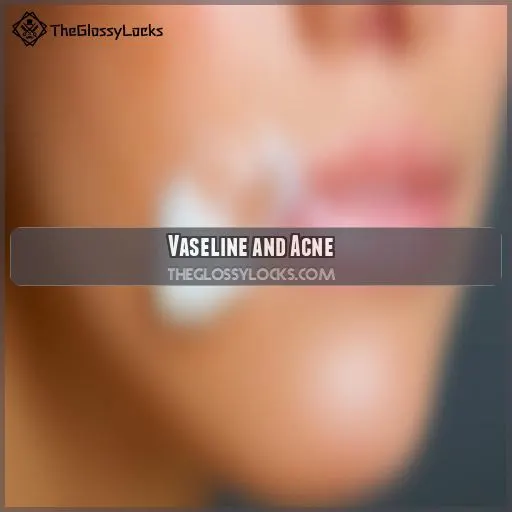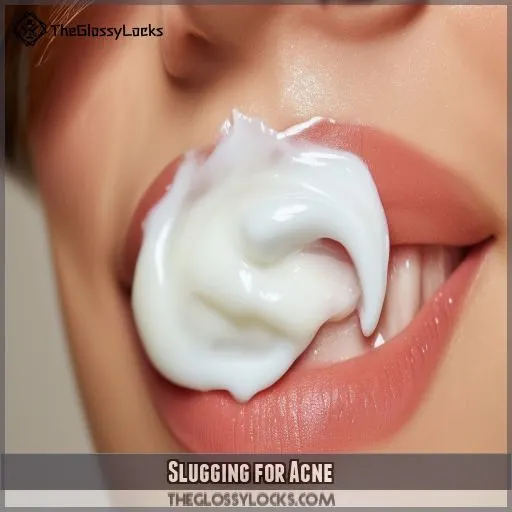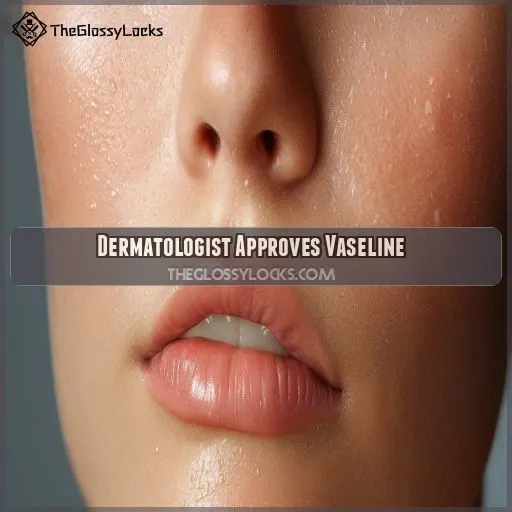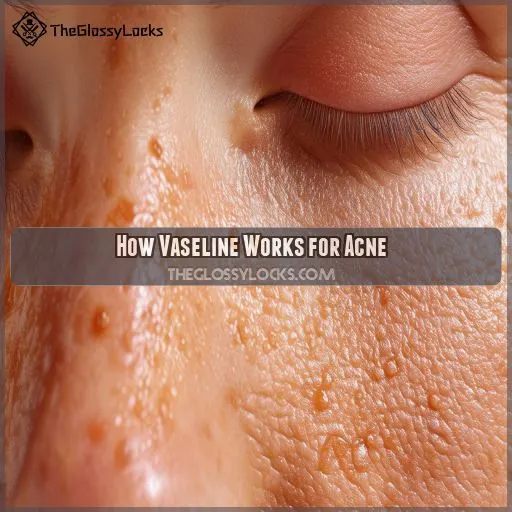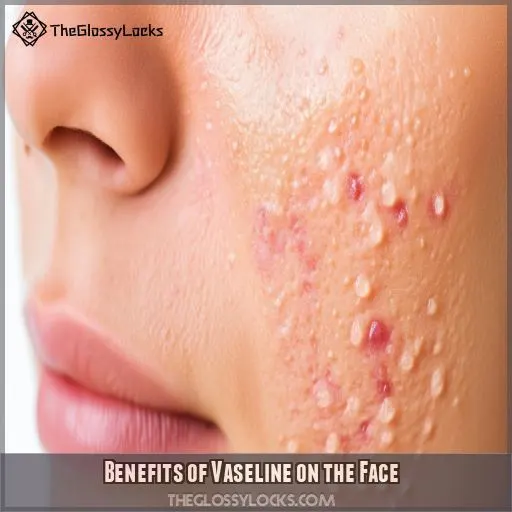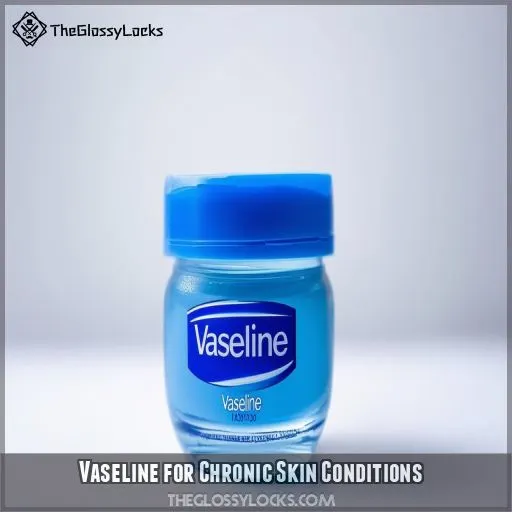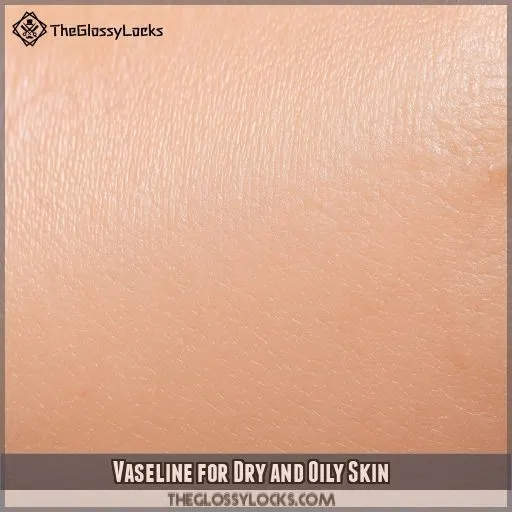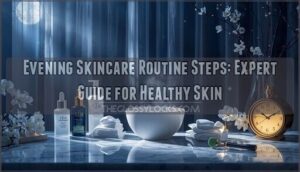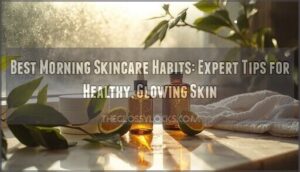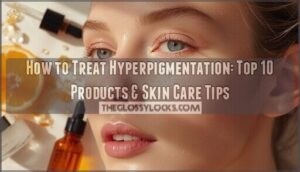This site is supported by our readers. We may earn a commission, at no cost to you, if you purchase through links.
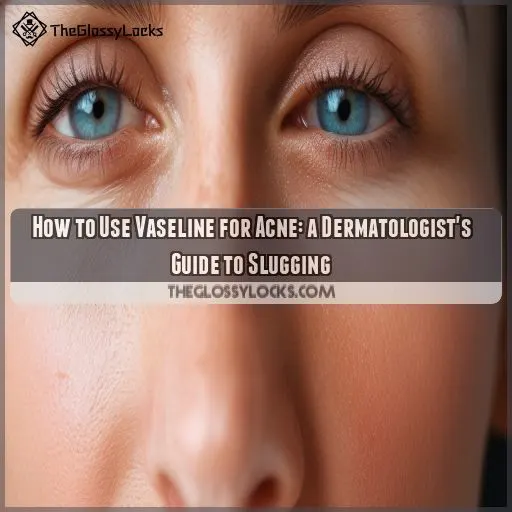 You might be surprised to learn that acne affects around 50 million people in the United States each year.
You might be surprised to learn that acne affects around 50 million people in the United States each year.
It is a common skin condition, but what is the best way to treat it?
Many people are turning to an unlikely source: Vaseline.
This article will explore how to use Vaseline for acne, including the benefits and risks, as well as tips from dermatologists on how to get the most out of this inexpensive product.
Table Of Contents
- Key Takeaways
- How to Use Vaseline for Acne?
- Vaseline and Acne
- Slugging for Acne
- Dermatologist Approves Vaseline
- How Vaseline Works for Acne
- Benefits of Vaseline on the Face
- Vaseline for Chronic Skin Conditions
- Vaseline for Dry and Oily Skin
- Frequently Asked Questions (FAQs)
- Is putting Vaseline on acne good?
- Is Vaseline good for your face at night?
- Will slugging break me out?
- Can Vaseline remove dark spots?
- Can Vaseline be used to remove fake eyelashes?
- Does Vaseline help prevent diaper rash?
- How does Vaseline help with athletes foot?
- Can Vaseline be used to treat psoriasis?
- Can Vaseline be used to style eyebrows?
- Conclusion
Key Takeaways
- Vaseline as a Secret Weapon Against Acne: It serves as a non-comedogenic, protective barrier, locking in moisture and facilitating the healing process of breakouts.
- Enhancing Your Routine with ‘Slugging’: This practice involves using Vaseline to create a protective layer over your skincare products, sealing in moisture, and enhancing product absorption.
- Dermatologist-Approved for Acne-Prone Skin: Rest assured that Vaseline is a safe and effective choice for acne-prone skin, backed by dermatologists, and can contribute to reducing breakouts.
- Tailoring to Your Skin Type: While Vaseline works wonderfully for dry and acne-prone skin, those with oily or sensitive skin types may find alternative options more suitable.
How to Use Vaseline for Acne?
Vaseline is a versatile product that can be used to manage acne. Due to its large molecules, Vaseline doesn’t clog pores, acting instead as a protective barrier for your skin. This barrier also helps lock in moisture, an important step in any skincare routine, especially for acne-prone skin.
If you want to know more about how Vaseline can benefit your skin, keep exploring.
Vaseline and Acne
Vaseline has been a staple in many households for decades, and its use for acne is a topic of interest. You may be wondering if this humble petroleum jelly can really help with those pesky pimples. Well, the short answer is yes, Vaseline can be beneficial for acne-prone skin.
First and foremost, it’s important to know that Vaseline doesn’t cause acne. It doesn’t clog pores or lead to breakouts and blackheads. In fact, it might even help cure your acne. How so? Well, Vaseline acts as a protective barrier on your skin, locking in moisture and keeping your skin hydrated. This is especially important for acne-prone skin, as proper lubrication can help improve its appearance. Think of it as a big hug for your skin, helping it to heal and calm down.
Now, it’s important to remember that everyone’s skin is unique, and what works for some may not work for others. While Vaseline is generally safe for acne-prone skin, it mightn’t be the best choice if you have excessive oil or are prone to comedones (those pesky little bumps). If you’re using retinoids to treat your acne, Vaseline might increase irritation, so proceed with caution. Always patch test and consult a dermatologist if you’re unsure.
Slugging for Acne
Slugging enhances the effectiveness of your regular skincare products by sealing them in with an occlusive layer. It aids in skin repair and reduces breakouts, creating a smoother and more even complexion.
Enhancing Product Effectiveness
Slugging enhances the effectiveness of your skincare routine by helping to lock in moisture and improving product penetration. Here’s how:
- Create a protective barrier: By applying Vaseline as the final step of your routine, you seal in the products and create a barrier that prevents transepidermal water loss.
- Improve skin hydration: This technique is especially beneficial if you have dry skin or a compromised skin barrier.
- Enhance product absorption: Slugging makes certain that your serums and moisturizers penetrate deeper into the skin, maximizing their effectiveness.
Aiding Skin Repair
Slugging is more than just a trendy skincare technique. It can aid in skin barrier repair, which is essential for maintaining healthy, acne-prone skin. By reducing transepidermal water loss, slugging helps to keep your skin hydrated and promotes healing.
However, it’s important to remember that slugging may not be suitable for everyone. If you have rosacea, psoriasis, or are prone to clogged pores, consult a dermatologist before incorporating the slugging technique into your skincare routine. While Vaseline is occlusive, it can also seal in substances on the skin, so be mindful of what you apply beforehand.
Reducing Breakouts
Slugging is an effective way to reduce breakouts and enhance your skincare routine. Here’s what you need to know:
- Slugging benefits: By sealing in moisture and boosting product absorption, slugging helps to calm and clear acne-prone skin.
- Slugging safety: While Vaseline is safe for most, it may not be suitable for acne-prone or sensitive skin. Always patch test and consult a dermatologist if unsure.
- Vaseline alternatives: If you’re hesitant to use Vaseline, try lighter occlusives like jojoba oil or hyaluronic acid.
- Overnight results: Slugging is typically done overnight to allow active ingredients to work while you sleep, revealing calmer skin by morning.
Dermatologist Approves Vaseline
Dermatologist Mona Gohara recommends Vaseline for acne-prone skin. Clinical studies have proven its effectiveness in reducing acne.
Vaseline is non-comedogenic, meaning it won’t clog your pores. It’s safe to use, even if you have acne, and can actually help to nurture and improve the appearance of broken-out skin.
However, it’s not for everyone. If you have facial acne, it might trap oil and debris, making your condition worse. Similarly, if you’re using retinoids, Vaseline could irritate your skin further. It’s also not recommended if you have sensitive skin or are prone to milia.
How Vaseline Works for Acne
Vaseline’s large molecular size prevents it from clogging your pores. By forming a protective barrier on your skin, Vaseline can help nurture and soothe your broken-out areas.
Molecules and Pores
Vaseline’s molecules are too large to clog your pores. It’s non-comedogenic, so it’s safe to use on acne-prone skin.
Forming a Protective Barrier
As an occlusive moisturizer, Vaseline acts as a protective barrier on your skin.
It locks in moisture and shields against external irritants.
This barrier function is key to its effectiveness in acne management. By sealing in hydration, Vaseline supports the skin’s natural healing process, aiding in the repair and calming of breakouts.
This simple yet powerful step enhances the skin’s resilience and promotes a clearer complexion.
Nurturing Broken-out Skin
You might be wondering what allows Vaseline to assist in healing acne. Well, it’s all about generating a favorable environment for your skin’s recovery. Here’s a simplified breakdown:
- Skin Barrier Support: Strengthening the skin’s natural barrier, which is often weakened in acne-prone skin, keeps irritants out and moisture in.
- Protecting and Soothing: The protective layer formed by Vaseline shields your skin from external aggressors, giving it time to heal and reducing further irritation.
- Moisture Retention: By locking in moisture, Vaseline ensures acne-prone skin stays hydrated, which is essential for promoting skin repair and a healthy complexion.
Benefits of Vaseline on the Face
Using Vaseline on your face can offer multiple benefits, from effectively removing eye makeup to locking in moisture, which keeps your skin hydrated. Additionally, it aids in the healing of minor cuts, protects chapped lips, and helps in grooming your eyebrows.
Makeup Removal
Vaseline can effectively remove eye makeup. Incorporate Vaseline into your makeup removal routine by applying it to a cotton pad and gently wiping away eye makeup. The double cleansing method involves using an oil-based cleanser, like Vaseline, followed by a water-based cleanser to guarantee your skin is thoroughly cleansed.
Moisture Retention
Vaseline locks in moisture, keeping your skin hydrated and healthy. It’s a great way to guarantee your skin stays moisturized throughout the day or night.
Minor Wound Healing
Vaseline helps heal minor wounds like cuts, scrapes, and burns. It keeps wounds moist, reducing scab formation and excessive scarring.
Lip Protection
Chapped lips? Vaseline is your lip care savior. It works as a protective lip balm, sealing in moisture and preventing dryness. Kiss dry lips goodbye!
Eyebrow Grooming
- Eyebrow shaping
- Brow taming
- Brow hold
- Brow growth
- Brow definition
Vaseline for Chronic Skin Conditions
Vaseline isn’t just for acne; it can also help manage chronic skin conditions like rosacea and psoriasis. By sealing in moisture, it can protect inflamed skin and soothe dry patches.
Rosacea and Psoriasis
Besides benefiting your face, Vaseline can also be used to manage chronic skin conditions like rosacea and psoriasis.
If you have rosacea, you know how challenging it can be to calm inflammation and reduce redness.
Vaseline can help protect inflamed and red skin, working to heal and soothe these sensitive areas.
For those dealing with psoriasis, Vaseline can seal in moisture in the affected areas, providing much-needed relief.
While it won’t cure these conditions, Vaseline can be a helpful tool in your skincare arsenal to manage symptoms and keep your skin comfortable.
Aging
While Vaseline is more commonly known for its ability to lock in moisture and heal wounds, it may also be beneficial in your anti-aging skincare routine.
As we age, our skin loses elasticity and becomes more susceptible to wrinkles and fine lines.
Vaseline’s occlusive properties may aid in increasing the regulation of peptides, which are crucial for maintaining skin elasticity and reducing wrinkles.
However, more research is warranted to substantiate these potential anti-aging advantages.
Vaseline for Dry and Oily Skin
For dry skin, Vaseline locks in moisture and soothes chafed areas, making it an excellent choice. However, if you have oily skin, it may feel heavy and greasy, so use sparingly to avoid trapping oils and sebum.
Dry Skin Benefits
If you have dry skin, Vaseline is a safe and recommended option.
It soothes chafed and dry skin and is gentle on the delicate eye area.
One of its key benefits is its ability to lock in moisture and oils, creating a protective barrier on the skin.
However, this same quality may lead to a heavy or greasy feeling on the skin as it seals in oils and sebum.
Oily Skin Considerations
While Vaseline is safe for oily skin, it may not be the ideal choice for those with combination or extremely oily skin types.
This is because it can leave the skin feeling heavy and greasy, as it seals in oils and sebum.
If you have oily skin, it is advisable to use Vaseline sparingly and explore alternative ingredients that are better suited to your skin type—lightweight formulas that cater to oily skin.
Limit the use of Vaseline to your nighttime skincare routine, as applying it during the day may lead to skin irritation or an excessively shiny complexion.
Frequently Asked Questions (FAQs)
Is putting Vaseline on acne good?
It depends on your skin type. Vaseline can help prevent acne scarring and lock in moisture, but it may also clog pores and worsen acne for some individuals.
Is Vaseline good for your face at night?
Vaseline is safe to use on your face at night. It’s a great way to lock in moisture and heal minor cuts. Just make sure to wash your face first, so you’re not locking dirt and oil into your pores.
Will slugging break me out?
Slugging may cause breakouts for some people, especially those with oily and acne-prone skin. It can trap dead skin cells, debris, oils, and bacteria, leading to more acne.
Can Vaseline remove dark spots?
Regular Vaseline can’t remove dark spots as it doesn’t contain any ingredients that would do this. However, Vaseline Expert Care Dark Spot Rescue is a dark spot-reducing formula that combines the power of niacinamide, pro-lipids, and Vaseline jelly.
Can Vaseline be used to remove fake eyelashes?
Yes, Vaseline can be used to remove fake eyelashes. It’s a cheap, easy, and safe way to dissolve lash glue. It’s important to use the brand name Vaseline, as other brands may contain harmful carcinogens.
Does Vaseline help prevent diaper rash?
Vaseline can prevent a barrier that keeps out moisture and may help prevent diaper rash if placed on clean, dry skin. However, moisture can be trapped under the petroleum jelly, which can cause or worsen a rash. Clinical trials have found no significant improvement in the prevention of diaper rash when using Vaseline.
How does Vaseline help with athletes foot?
Vaseline is an occlusive moisturiser, reducing water loss from the skin. It forms a hydrophobic barrier on the foot, reducing sweat for the fungus to thrive on. Apply it all over the sole of your feet, including between the toes, and put on a clean pair of socks.
Can Vaseline be used to treat psoriasis?
Vaseline soothes dry, itchy skin, and can be used to treat psoriasis. It’s safe to use, but may not be recommended for everyone with psoriasis. Speak to a healthcare professional before applying it directly to psoriatic skin.
Can Vaseline be used to style eyebrows?
Yes, Vaseline can be used to style your eyebrows. It can give them a fuller appearance and help them stay in place.
Conclusion
So, should you try using Vaseline for acne? It’s a tempting proposition, especially considering its reputed benefits for skin repair, moisture retention, and protection.
However, it is always wise to consult a dermatologist first. They can offer personalized guidance and advice tailored to your specific needs.

